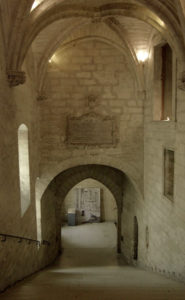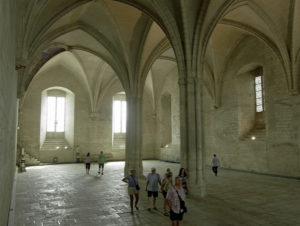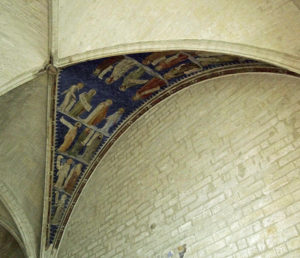The “tour”:https://tinyurl.com/y2zqtz74 begins in the large Courtyard of Honour separating the Old and New Palaces. The difference in architecture between the two is clearly visible with the Old palace on the left. In the corner is the Indulgence window used to present a new Pope and for Papal blessings.
A doorway and corridor leads into what is described as the Cloisters in the centre of the Old Palace. The gallery gives access the the different parts of the old palace. Many of these now house the archives which are not open.
The first room visited is the Consistory Room. The Pope surrounded by his Cardinals sat on a throne at one end. They deliberated on major political, judicial and theological issues and received foreign dignitaries or gave public audiences. The room is now used as an exhibition space. The remains of wall paintings by Matteo Giovannetti can be seen round the top of the walls. Off the Consistory Room is the Chapel of St John whose walls are covered by “frescoes.”:http://www.horizon-provence.com/palais-des-papes-avignon/photos/palaisneuf06.jpg This is admired from the doorway and there is no photography allowed.
Next to this is the Grand Tinel which was the Papal banqueting hall and would have been decorated with frescoes. Banquets were lavish and could last for several days. The remains were given to the poor of Avignon. The room was also used for conclaves to elect a new pope.
Off it is the chapel of St Martial (again only visible from the doorway and no photographs) with its beautiful painted “frescoes,”:https://en.wikipedia.org/wiki/File:Plafond_de_la_chapelle_Saint-Martial,_par_JM_Rosier.JPG with scenes from the life of St Martial. The deep blue colour comes from lapis lazuli.
Beyond the Grand Tinel is the Parement Chamber 714 which acted as an antechamber to the Pope’s private apartments. People granted a private audience with the Pope waited here. The Pope and his cardinals could also debate in private here. Its walls would have been hung with tapestries hence the name. On the walls are the remains of a false marble dado dating from the C14th. There are also displays of Medieval tiles.
A narrow passageway and stairs lead to the Pope’s bedroom in the Papal Tower. The walls here are covered with wonderful “frescoes.”:http://www.palais-des-papes.com/sites/default/files/styles/img_vertical_grand/public/dsc_2774.jpg?itok=oU_9GUKZ These form scrolls of vine leaves painted on a pale blue background. The brightly coloured floor tiles are reproductions of Medieval tiles. Beyond is the Pope’s Office with walls covered with “hunting”:http://www.palais-des-papes.com/sites/default/files/styles/img_carre/public/nb0413avignonfresque.jpg?itok=I5pNzzZB and “fishing scenes.”:http://www.wga.hu/art/m/master/xunk_it/xunk_it2/08scene3.jpg
Beyond the private apartments, the tour enters Clement VII ’s New Palace. The sacristy now houses statues including a polychrome entombment and copies of statues of French kings and queens. This leads into the Grand Chapel, now a large bare space used for exhibitions. The doorway from the ceremonial staircase and Indulgence window is particularly splendid.
The ceremonial staircase was used for major ceremonies leading to the chapel from the Courtyard of Honour. Guard rooms off it were used to keep watch and control over entry to the Chapel.
Below the Chapel is the Audience Chamber. This is a large empty space with massive pillars supporting the rib vaulted ceiling. There are the remains of frescoes on the walls, including a C15th Coronation of the Virgin. One of the roof vaults still has the remains of a Matteo Giovannetti fresco showing Old Testament kings, prophets and patriarchs.
A series of rooms off the chapel leads to the staircase to the Audience Tower with the terrace cafe. It is worth climbing up here for views down onto the Palace, the Cathedral and also Avignon.
I’m not sure that I would bother with a guided tour again. It was a large group and the Palace was busy. It quite difficult to hear wheat the guide was saying even though we had earphones. There are Information boards in English in each of the rooms. The main advantage was not getting lost and making sure we did see all the the palace. Another time I think I would just use the audio guide from the ticket office.
I visited here on Day 7 of Burgundy, the River Rhone and Provence, a river cruise with Riviera Travel.
My full account with all the pictures can be found “here.”:http://wasleys.org.uk/eleanor/otherholidays/rhone/index.html here.










